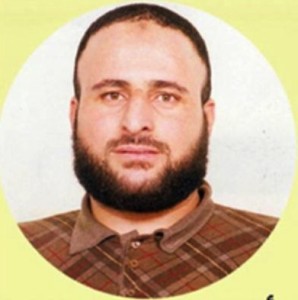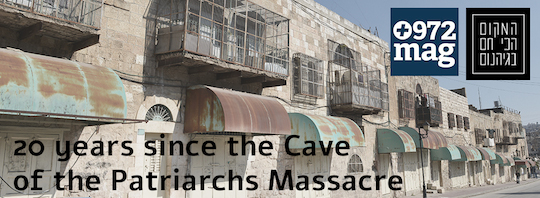On Purim of 1994, Dr. Baruch Goldstein massacred 29 Muslim worshipers in the Cave of the Patriarchs – a tragedy that sparked a chain of events that has, more than any other act, shaped the Israeli-Palestinian conflict for the last 20 years. But we could point to a much earlier start of this story: an Arab doctor who will never forget the Jewish physician who saved his life, and convict No. 397, serving a life sentence.
By Yizhar Be’er (translated from Hebrew by Michal Wertheimer Shimoni)
The massacre at the Cave of the Patriarchs in Hebron on Purim (February 25, 1994), 20 years ago, was a decisive moment in the history of the Palestinian-Israeli conflict, which brought on a wave of suicide attacks inside Israel, and led eventually to the creation of the murderous impulse in Yigal Amir, who then assassinated Yitzhak Rabin. Until then, there had been an internal discussion going on among the Shari’a Wise Men, about suicide attacks against civilians within Israel’s borders, and they had refrained from sending them into Israel. The way suicide in Islam is treated by individuals depends on the Shari’as adjudicators, who, in turn, rely on the Quran. On the one hand, the Quran negated suicide (“and you shall not throw yourself to destruction”), as opposed to the more positive approach to suicide reflected in the idea of the shahid (martyr), who dies fighting against Islam’s enemies.
As we can see from history, the Muslim suicide terrorist was not born in the 20th century. Many myths are connected to the Hashashashins, the first Muslim suicide attackers of the 12th century. Some factions of modern Islam have taken on suicide attacks as an effective mode of combating enemies even before the Cave of the Patriarchs Massacre. (Suffice is to mention the horrible suicide attacks of Hezbollah against American, French and IDF troops in Lebanon, which led in effect to their expulsion from the land). Nevertheless, the use of suicide attacks targeted at civilians was debated among Palestinians, and for various reasons Hamas did not send them into the Israeli population until the massacre at the Cave of the Patriarchs. For them, the massacre was the crossing of a line because of the attack against civilians, especially in a sacred place during prayer.
The first Palestinian Intifada started with strikes, tax boycotting, pamphlet spreading and stone throwing, and then escalated to knifing attacks after the Temple Mount massacre on October 9, 1990, in which 24 Palestinians were killed by Israeli policemen. From the signing of the Oslo agreements on September 13, 1993, and up until the massacre Goldstein carried out on February 25, 1994, 22 Israelis were killed, 10 of them within the Green Line. This number is close to the sum of Israeli victims during most of the first Intifada. During this period, Hamas was still avoiding using suicide terror attacks within Israel. The Hebron massacre changed the rules, when Hamas and Muslim Brotherhood ideological leader, and one of the most respected Islamic rulers, Yusuf Kardawi, published a fatwa (Muslim law ruling) justifying suicide attacks against Israeli civilians. He was also the first to allow Palestinian women to commit suicide attacks.
Right after the massacre, Hamas published an announcement, signed by the military branch of the organization, threatening to carry out five major attacks as revenge against the massacre. According to Islam, the first memorial day for the dead occurs 40 days after they die. Indeed, the first suicide attack within the Green Line was in Afula, on April 6, 1994, exactly 40 days after the massacre in the Cave of the Patriarchs (eight Israelis killed). The second revenge attack occurred a week later, on a bus in Hadera. Both attacks happened while IDF was still present in all of the Palestinian cities and before Arafat and his men arrived there as part of the Oslo agreements. After that there were attacks on bus number 5, in Tel Aviv, in Beit Lid, in Ramat Gan and in Jerusalem.
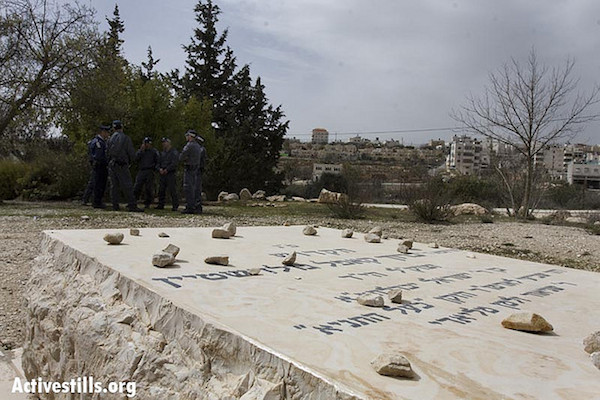
Yitzhak Rabin was assassinated on November 4, 1995, after 78 Israelis were murdered during the wave of suicide attacks that started after the Hebron massacre. Yigal Amir testified during his police investigation that he was heavily influenced by the book Baruch the Man, and from the personality of the man who committed the massacre. He also said that he wouldn’t have committed the murder had he not felt supported by the rabbis and public opinion. As his widower said in an interview to the Yedioth Aharonoth daily (March 3, 1994), Goldstein acted with the intention to hinder the Oslo agreement. “Baruch is not a psychopath. He knew exactly what he was doing. He planned to do it in order to stop the peace talks.”
The black stone
The story of the Cave of the Patriarchs massacre began a bit earlier. In as much as it has a beginning, it can be told starting one day in October of 1990. It was a day that started out peacefully, only to deteriorate into a cycle of death and revenge, mixing up the different factions fighting the mythological battle over the land in a strange blend. At the end of that year Mikhail Gorbachev was elected president of the USSR and started dismantling the Soviet Union. Here in Israel,Yitzhak Shamir put together a new government after dismantling Peres’ “dirty trick.” The First Intifada, entering its third year, was still a popular unarmed uprising, mostly comprising of stone throwing, pamphlet distribution, strikes and tax boycotting. It would all change as a small group of “Temple Advocates”, lead by Gershon Salomon, announced its intention to drag a stone onto the temple mount, meant to be the corner stone of the third temple.
This tragic story begins with that mythological stone, a divine particle of sorts, intended to show who’s hand rules this land. This stone rolled into one of the most explosive places on earth and started a revenge cycle that influenced many lives and to a large extent changed the nature of the conflict.
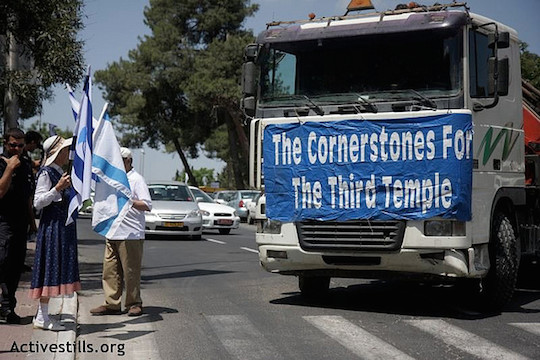
Like every year ahead of the Jewish holiday of Sukkot, when the ceremony of moving the stone would take place, in 1990 the police did not allow Salomon’s friends into the Old City of Jerusalem and redirected them to the Shiloah spring water source in Silwan, which would become “The City of David” a few years later. However, the Muslim citizens’ concerns were not quieted and so on the morning of October 8, over 3,000 of them assembled at the Temple Mount. The Mu’azin of Al Aqsa talked about the necessity of protecting Jerusalem’s Muslim character, as well as the mosques. A few dozen policemen spread out on the Temple Mount, but nothing extraordinary happened. Things were under control and police commanders Rahamim Comfort and Aryeh Bibi did not even bother showing up – which cost them their jobs later on.
At 10:30, however, a coincidence of sorts took place, one which changed everything. A moment of carelessness made a policeman drop a tear-gas grenade from his hands, which rolled over towards a group of women and ignited the scene. The Palestinians there started throwing stones and everything possible at the policemen, aiming at the Temple Mount plaza and Ofel Street, east of it. The deputy of the Mufti, Elgamal Al-Rifai’s attempts to deescalate the situation did not succeed and the Muslim protesters attacked the policemen and drove them away through the Mughrabi Gate. Then they turned and attacked the police outpost of the Mahkama, which was only manned by the duty officer. They hit him and burned down the station. Out of fear for his life and shame about the retreat of their men, large numbers of police furiously broke into the Temple Mount using live fire. The results of that day were 24 Palestinian dead and some 200 wounded. No one was killed on the Israeli side and 20 policemen were injured.
Abu Sirkhan
A few days later, under the influence of these events, Amar Abu Sirkhan, an 18-and-a-half-year-old plasterer, woke up at 5:30 in the morning at his parents’ house in the Abadia neighborhood, near Bethlehem, and decided to go on a revenge spree in Jewish Jerusalem. To his police interrogators he said: “My final decision to take revenge was made because of what happened on the Temple Mount. I was thinking about it for a whole week and I knew I was coming to spill the blood today.” Abu Sirkhan left his house at 6 a.m., hiding a long and narrow-bladed combat knife in his clothes. A Palestinian bus dropped him on Hebron Road, not far from the building site where he worked. His employers told the police that he was a normal and diligent worker. “Nothing in his behavior gave away his plot,” they told police.
He walked along the inner roads Jerusalem’s Baq’a neighborhood to Ya’ir Street, where he came upon Iris Azulai, a soldier on her way to her army base. The neighbors remember a blood curdling scream of a girl, at 10 minutes to 7 a.m., and then a flood of dog barks. The neighbor, Tzipi Kleiner, repeated her words: “Help! He’s stabbing me!” Hearing the screams, the neighbors came out of their homes. Micky Stark and his wife, both of them physicians, he the CEO of Misgav Ladakh Hospital, as well as Dr. Yitzhak Vinograd, head of the surgical department at Assaf Harofe Hospital, tried in vain to save Iris’ life. Juliette, her mother, lost control when she saw her daughter dying and attacked the policemen who arrived before the ambulances. At the same time, Abu Sirkhan was running along Barak Street, where he came upon Amikam Kovner, a 13 year old boy, but the dogs that attacked him saved the boy’s life. Abu Sirkhan ran a further 200 meters, where he met his next victim, Eli Alterz who was an artist and owned a nursery, holding potted plants in his hands. He stabbed him at least 10 times. The policemen who found him lying in a large pool of blood could only cover his face.
A special forces officer called Charlie Shlush who heard what was happening took his gun and ran towards the stabber. The neighbors testified later that he yelled three times “Stop! I don’t want to kill you!” But Abu Sirkhan was in an panic attack and did not stop. Shlush shot him twice in the legs and tried to grab his shoulders and bring him down but Abu Sirkhan, who was big and heavy managed to stab Shlush once. The two men continued to wrestle each other until Shlush collapsed dead on top of Abu Sirkhan. His wife, heavily pregnant, ran over and saw her husband’s corpse. “That’s the end, I’m dying,” she was later quoted as saying by Yedioth Aharonoth. The neighbors said that they took the opportunity to kick-in Abu Sirkhan’s face until the police arrived.
Next day the New York Times reported from Jerusalem about a Palestinian running amok in the quiet Jewish neighborhood, stabbing to death with a 15-inch knife an unarmed soldier, a gardener and a policeman who tried to stop him. The newspaper linked the stabbing to the killing of Palestinians by the police two weeks beforehand at the Temple Mount. Amar Abu Sirkhan was tried in a military court on three counts of murder and given to three life sentences. His family’s home in Abadia was demolished.
Shlush
Two months after the stabbing in Bak’a, On December 27, the newspapers ran a brief report about another violent event in the occupied territories. An unknown man opened fire on a Palestinian family’s car in Gush Etzion near Bethlehem, badly wounding the travelers – Dr. Faisal Amro, a physician from Hebron, His sister Ibtisam and her daughter Aya.
A group of extremist settlers going by the name of “the Zionist avengers” claimed responsibility for the event. This caused a public uproar. Left-wing spokespeople feared the establishment of a new Jewish underground, only five years after the exposure of the Jewish underground of the 1980s, and after most of its tried and convicted members had been pardoned and released from jail. Member of Knesset Haim Ramon claimed that: “the forgiveness and support which the underground members received after being released from jail is a source of inspiration which will increase the danger of new terror organizations, and should be firmly suppressed, or else they will cause the ‘Lebanonization’ of Israel.” Member of Knesset Yossi Sarid named all those who participated in the release of the underground murderers as responsible for the assassination and called for self-examination. Later on, however, findings pointed toward a lone shooter seeking revenge, and not toward a new underground. Military police found out that Arye Shlush, brother of Charlie Shlush, who was stabbed by Abu Sirkhan at Bak’a, served at the Gush Etzion military base near Bethlehem. When the investigators came to the base, they found him crying in his room. He immediately confessed that he had shot the Arabs as revenge for his brother’s death. Policemen testified that all along he cooperated with them and behaved calmly.
A probation officer described Arye Shlush as a quiet, humble and good hearted boy, who was destabilized by the death of his revered brother. The tragic event haunted him, and he desperately asked his commanding officers to be transferred from the occupied territories for fear of not being able to control his urge to hurt Arabs. His requests were denied. Two months after his brother’s death, he succumbed to this urge.
Unlike his brother’s stabber who was tried before a military court, Arye Shlush was tried before a civilian court, despite his being a soldier. He was sentenced to seven years in prison. “The circumstances of this case are absolutely tragic,” Judge Meir Shamgar, president of the Supreme Court, wrote dryly when giving the background to his verdict at the appeal requested by his attorneys. He described in detail the sequence of events: how Shlush approached his commanders, verbally and in writing, asking to transfer him, as he feared he would not be able to control the rage and his urge to seek revenge, which was welling up inside him. Only after the event, and following Shlush’s appeal to the military ombudsman, was an investigation conducted, and a lieutenant-colonel was reprimanded for not taking proper care of his request to be relieved from serving in the occupied territories.
Although it was determined that Arye Shlush was a normative soldier, and despite the fact that his behavior up until the attack as well as after he was convicted and sent to jail were impeccable, his request to shorten his sentence was denied. “We could not reduce his sentence. The appellant’s deed, stemming from a wish to hurt others because of their national identity, hurt three innocent people and miraculously did not end in tragedy,” wrote Shamgar.
Dr. Amro
I first met Dr. Faisal Amro in Hebron by chance. When we sat together his leg was accidentally exposed and I saw a huge scary indentation in it. “Shu ya’ani?” I wondered. He told me how he drove on that fateful night of December 12, 1990 to the Bethlehem hospital with his wife who was about to give birth, and how he drove back to Hebron after midnight with his sister Ibtisam and her nine-month-old daughter. And how the soldier Arye Shlush had waited and then shot and nearly killed them and only a coincidence saved their lives. He also told me about the Jewish physician who saved his life.
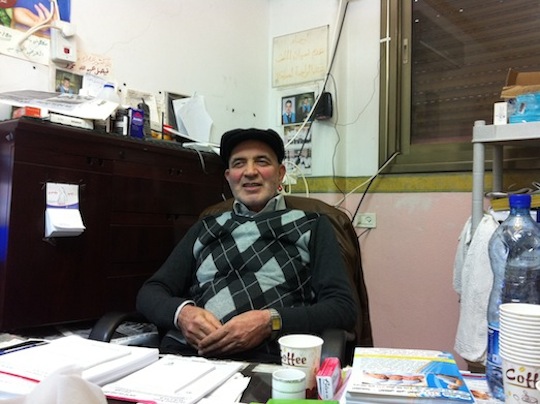
At the Gush Etzion junction an armed soldier wearing a kippa stopped them, he told me, “when I slowed down he started shooting at us.” Ibtisam was wounded and screaming. “I opened the door and went over to help her. “I’m a doctor! I’m a doctor!” I yelled in Hebrew toward the shooter, but to no avail. The soldier shot him again and again, 14 shots in all parts of his body. His sister said that the shooter yelled to her that both she and her brother should die, while she tried to stop the bleeding from her brother’s chest and begged him to stop shooting.
“We were all hurt but I was the most severely injured,” he told me. “As a physician, I understood my situation. I knew I was finished. I told my sister to turn me towards Mecca.” Dr. David Micha’eli, the Jewish physician who came in the ambulance from Gush Etzion, saw that the wounded man was in dire condition and that he had lost a lot of blood. “I was mostly conscious,” said Amro. The last thing he remembers telling Dr. Micha’eli was, “I’m dying!” Indeed, he died. Or so the physician said on the way to Hadassa Hospital in Jerusalem, when he discovered that there was no pulse.
But what are they supposed to do in Hadassa with the body of a deceased man from Hebron? Dr. Micha’eli told the ambulance driver to turn around and drive to Hebron in order to transfer the body at the military governor’s. In the middle of the journey they came across another ambulance that had been called from Kiryat Arba. The two ambulances, coming from opposite directions, stopped next to each other. “You’re late!” said the Gush Etzion physician to his colleague from Kiryat Arba. The colleague suggested they use the blood he had with him to try and revive the body. A blood infusion was quickly set up for the deceased, blows and pumping were given to his chest, and the pulse returned. Once more the driver was asked to change direction and return to Hadassa. From his miraculous awakening in the emergency room after 36 hours, Dr. Amro remembers the monitor’s hum. “I blinked hard with my eyes, so that the nurse would notice that I’m alive.” His leg was black and he asked the doctors to amputate it. It took the blood vessel specialist a great effort to convince him to wait. The leg was saved. After three months of rehabilitation and an endless stream of visitors, including a few heads of state (Amro remembers Ezer Weizman, Yitzhak Mordechai, Shaike Erez and quite a few members of Knesset visiting), Faisal Amro returned to his home in Hebron, scarred and full of holes, but alive.
“Who was the physician who saved you?” I ask. “Dr. Baruch Goldstein,” he says, embarrassed. “So they tell me,” he says, trying to correct himself later. Dr. Faisal Amro knows very well, better than any other child in Hebron, who Dr. Goldstein is: The Jewish physician who murdered 29 Muslims at prayer time a week before Ramadan, on Purim of 1994. After a long silence I ask him: “And what do you think of your savior today?” Dr. Amro does not think long: “Kalb ibn-kalb!”
Dr. Goldstein
At the Shiv’a ceremony after the Bak’a murder attack, Iris Azulay’s father lamented: “my daughter, that innocent flower, is gone, a victim. What scares me is that this vile person who stabbed and killed her and is sitting in jail now will be released in some future exchange deal of terrorists for POWs.” He said that without knowing that his prophecy would come true 21 years later. The stabbing attack and the killing of Charlie Shlush, who tried to avoid killing his attacker, shocked the land. The Likud party tried to use the public furor following the event to promote a law that would pardon all the soldiers who were involved in illegal deeds at the beginning of the First Intifada. MK Reuven Rivlin said at the time that the criticism against the IDF following the verdicts in the Givati trials (for breaking Palestinians’ bones), and the depression felt by many in the IDF required putting an end to such criticism. Agriculture Minister Rafael Eitan demanded that whoever is caught carrying cold weapons be deported with his family to Lebanon. “We will not shoot them in the head because that is too extreme, but they need to be deported immediately,” he said. On the other hand, Teddy Kolleck, Jerusalem’s mythological mayor said that security will return to Jerusalem only when peace negotiations start. The head military prosecutor, Brigadier General Amnon Streshnov said in an interview to the military’s BaMakhane magazine that there is no doubt that if Charlie Shlush had shot to kill the stabber in Jerusalem, he would have been considered to be acting in self defense and would not have been put on trial.
In October of 2011 I was invited to be part of a panel at the Rabin Center in Tel Aviv, dealing with terror and human rights. I shared with my listeners, who were high-ranking IDF officers, this tragic story. One of the panel’s members, a former Border Police commander jumped and said that Charlie Shlush was a subordinate of his, a good man and a terrific fighter who was on his way to an officer’s course. He said that although the stabbing was very light, it had hit a blood vessel and as a result killed him. Another officer added that Arye, Shlush’s brother, was a close friend of his during their military service. “Shortly after Charlie died, a friend of ours was severely wounded. The coincidence was too much for him and he went on his revenge spree.”
A few days after that panel meeting at the Rabin Center, Israeli POW Gil’ad Shalit was released in return for 1027 Palestinian prisoners. Among them was also life-long prisoner no. 397, Amar Abu Sirkhan, who killed the soldier Iris Azulay, the gardener Eli Alterz and the policeman Charlie Shlush. He was not permitted to go back to Abadia and was deported to Gaza.
Security forces, negatively influenced by the Bak’a stabbing and Charlie Shlush’s failure to stop the stabber by shooting at his legs, escalated their use of ammunition and weapons such as 9mm bullets and rifles. Following this and other terror attacks, including the killing of a male and female soldier in Hebron, the saying, “better to have a bad lawyer than a good Hazan (traditional cantor for funerals),” became common.
Two years after his sentencing, Arye Shlush, who shot at Dr. Amro, received a pardon from President Chaim Herzog, nearly at the end of his term. Today he lives in Hosen, a village in western Galilee, and runs a carpentry shop making kitchens. He refuses to talk about the event.
Dr. Faisal Amro, the Palestinian physician, continues to see patients in his private clinic in Hebron. He has six brothers and six sons, all of them physicians, too, living in the “Doctors’ quarter” in the south of the city. When I visited him recently at his clinic, he described his suffering after all these years. At one point he took off his clothes to show me where four bullets were still embedded under his skin. “I pull out shrapnel every day”’ he said, “They stop me at every Magnetometer because of all the metal in my body. I don’t wish upon friend or enemy to suffer what I have. I don’t talk about it, not wishing to sadden others. It’s a great tragedy. When people ask me I’m not interested to talk about it”.
His resurrection after being declared dead is nothing less than a miracle. “In the fluttering between life and death I saw my patients praying for me. Dr. Micha’eli asked me what I have done in this lifetime that God gave me the gift of my life back, and I answered: God only knows!”
He doesn’t want to talk about Goldstein either. “Leave it,” he says, “people tried to talk to me about it but I don’t want it to be used politically.”
Would you agree to meet Arye Shlush, who shot you?
“No!” he says decisively. “What do we have in common? He’s the perpetrator and I’m the victim. He murdered three people in cold blood. That God had decided to bring me back has nothing to do with him.”
Dr. Baruch Goldstein, the extreme right-wing physician who treated Jews and Arabs, eventually succumbed to the unbearable emotional tension as a result of watching the reports of the terror attacks (he was especially affected by the murder of his close friends, the Lapid famaily, by Hamas members fighting against the Oslo agreement). He went on a killing spree that ended his life at the Cave of the Patriarchs on Purim, 20 years ago.
Goldstein, the first Jewish shahid of modern time, managed single-handedly to change the direction of the Oslo process. After the Cave of the Patriarchs massacre Hamas began mass murder attacks within Israel, and those in turn eventually led to Yigal Amir committing murder. Goldstein’s grave in Qiryat Arba became a place of pilgrimage and he has became saint-like for a widening circle of Israelis. Ironically, one of his sons became an IDF combat pilot.
Epilogue
After the Temple Mount events in October of 1990, there was an inquiry committee set up, headed by Tzvi Zamir, which concluded that the Muslims were to blame for inciting the attack on Jewish worshipers and policemen. The committee justified the use of live ammunition in breaking into the Temple Mount because, as they said, lives were in danger. B’Tselem accused the Zamir Commission of a cover-up. Benjamin Netanyahu, then deputy foreign minister, however, instructed Israeli diplomats worldwide to use the Zamir report as proof of Israel’s righteousness.
A week after the Temple Mounts event Supreme Court Justice Ezra Kama was appointed to investigate the circumstances of the killing of Palestinians during the riots. In contrast to the Zamir report, Kama heard about 100 witnesses from both sides and held 20 meetings. He was critical of the police and determined that “at the break-in stage the forces got carried away and started shooting.” He negated what the Zamir Commission said about the chain of events at the beginning of the riots and determined, like the Wakf’s report before his, that the event started after a Border Patrol officer mistakenly dropped a tear gas grenade. He pointed out that the Muslims chose to ignore the police announcement that they will prevent the ascent of the “Temple Mount trustees” to the Mount, but did not find evidence for incitement, written or vocal, as the Zamir Commission claimed. No knives and axes were prepared ahead of time, he declared.
The Temple Mount events in October of 1990 were a decisive moment in the history of the Jewish-Palestinian conflict. As a result the Intifada escalated and for the first time Palestinian were encouraged to move from stone throwing to the use of knives. The call for escalation was expressed by Hamas as well, who declared that any Jew is a good target. Indeed, in the following two months, Palestinians stabbed eight Israelis. During police interrogations, the attackers claimed they were avenging the victims of the Temple Mount event.
Former head of Shin Bet (Israel Security Agency) Ami Ayalon said that this was the most important event that had happened in the occupied territories since 1967, as it was a major catalyst for the Intifada, and a catalyst for the switch from stones to knives and then to firearms. The event introduced powerful religious elements into the conflict, which was mostly nationalistic until then, and deeply and emotionally influenced both sides, he said. Following the horrific event on Temple Mount, police curtailed visits on the Mount by religious Jews. At first members of the Temple movements were completely banned, and later they were allowed to visit, but in pairs only, accompanied by a policeman. These limitations were relaxed over time (as we learned from the report released recently by Keshev and Ir Amim about the Temple Mount, “A Dangerous Connection“). In addition to Gershon Salomon’s weirdos there exist dozens of Temple organizations, some of which are funded by the state and politically supported by the ruling party in Israel. These modern zealots claim that nothing will deter them from the Great Plan of Redemption. The cornerstone of the Temple, which sparked the cycle of violence and revenge in October 1990, is still awaiting its divine opportunity to show who really rules the land.
Claims that the Oslo proceedings brought on the suicide attacks purposely disrupts the historical chain of events. It is misleading and possibly false. The mass suicide attacks which started after the Cave of the Patriarchs massacre escalated after the killing of “the engineer,” Yahya Ayyash, and again after Ariel Sharon came into power, after the peace process was stopped. During the two years of Ehud Barak’s premiership, 1999-2001, at the height of the political negotiations, not one Israeli citizen was killed in suicide attacks. In the first year after he was replaced by Sharon, 86 Israelis were killed and in the following year 225 people were killed.
Unlike what Israeli peace-opposing forces claim, it was not the Oslo agreements that brought about exploding buses; it is more accurate to say that it was the veto power of the extremists, unleashed by Baruch Goldstein. He was fed by the radical spirit of Messianic Judaism, which joined forces with Islamic radicalism in a demonic way, to end the peace process in a dance of blood and tears.
This article was first published in Hebrew on the Haokets website. Yizhar Be’er is a former journalist for Haaretz and former director of B’Tselem who serves today as director of Keshev, which monitors Israeli media coverage.


